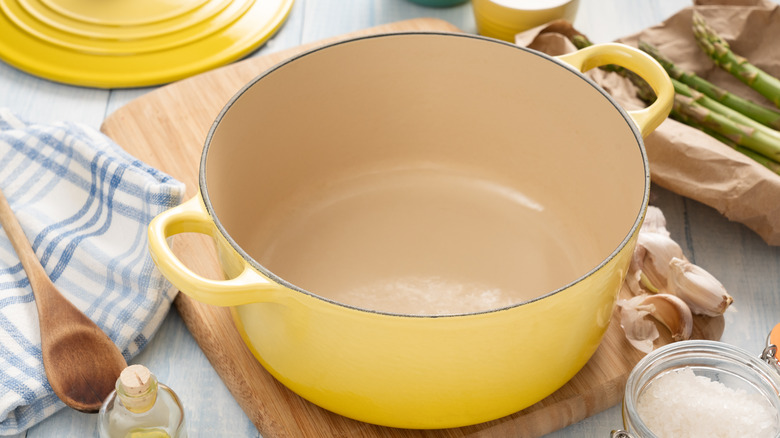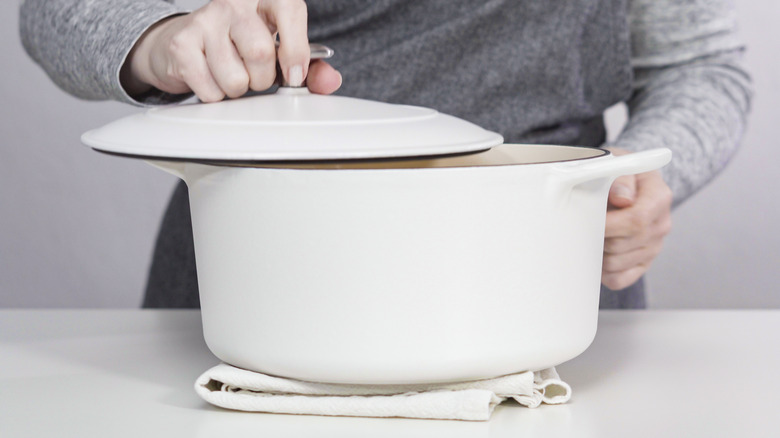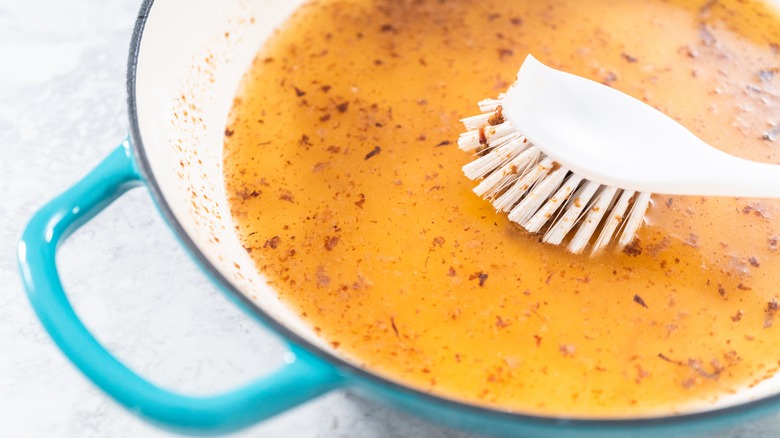The Household Staple That Will Leave Your Dutch Oven Sparkling
Dutch ovens can be challenging to clean due to their thick, often porous, cast iron construction and their tendency to accumulate stubborn, baked-on residues from slow-cooking and braising. Their porous surfaces absorb flavors and oils, requiring extra care to prevent flavor transfer between dishes. Moreover, their cast iron's reactive nature makes them susceptible to rust if they're not dried promptly after washing. Additionally, the weight and bulk of Dutch ovens can make handling and cleaning them more cumbersome compared to lighter kitchen cookware. Proper maintenance involves seasoning them to maintain a protective layer and utilizing gentle cleaning methods to preserve their integrity, making them more demanding in terms of care compared to other kitchen cookware. Nevertheless, one great pair of cleaning agents that will leave your Dutch oven sparkling is hydrogen peroxide and baking soda.
Hydrogen peroxide and baking soda create an effective cleaning duo for enamel Dutch ovens due to their complementary properties. Baking soda, a mild abrasive, aids in scrubbing away stubborn residues without damaging a pot's surface. Meanwhile, hydrogen peroxide serves as a powerful oxidizing agent, breaking down and lifting tough stains. When combined, these two ingredients form a synergistic reaction that enhances their individual cleaning abilities. The baking soda and hydrogen peroxide create a bubbling action that helps to dislodge and dissolve grime. This chemical reaction is particularly useful for tackling baked-on, caked-on, or burned-on residues, making the combination a potent and natural solution for restoring the cleanliness of Dutch ovens without resorting to harsh chemicals.
How to clean your Dutch oven
Cleaning an enamel Dutch oven with hydrogen peroxide and baking soda is an effective and chemical-free method that can restore its pristine condition. It's important to only use this method on enamel Dutch ovens and not on complete cast-iron cookware. Begin by rinsing the Dutch oven with warm water to remove any loose debris. For stubborn, stuck-on residue, allow the pot to soak in warm, soapy water for about 15 minutes. This helps to loosen the grime, making it easier to clean.
When soaked, create a paste using baking soda and hydrogen peroxide. Combine equal parts of both ingredients until a thick, spreadable consistency is achieved — about 2 tablespoons of each. Apply this paste generously to the interior of the Dutch oven, focusing on areas with built-up stains or discoloration. Add a few drops of dish soap and a cup of water and then bring the solution to a low boil over low heat for 15 to 20 minutes. When cool, use a nonabrasive sponge or cloth to scrub the interior, paying attention to the edges and corners.
Rinse the Dutch oven thoroughly with warm water to remove any residue. If necessary, repeat the process until the desired level of cleanliness is achieved. Finally, dry the Dutch oven completely before storing it to prevent any potential rusting or degradation. This natural cleaning method offers a safe and eco-friendly way to rejuvenate an enamel-coated Dutch oven, leaving it ready for future culinary adventures.
Cautions for using this method
While hydrogen peroxide and baking soda can be effective for cleaning a Dutch oven, some cautions should be considered. The use of these substances may not be suitable for all enamel-coated Dutch ovens because some can potentially cause damage to the finish. Checking the manufacturer's guidelines and recommendations for cleaning specific types of Dutch ovens to ensure compatibility with hydrogen peroxide and baking soda is crucial, particularly if the enamel only covers the interior of the cookware.
Moreover, if the Dutch oven has intricate designs, patterns, or decorative elements, the abrasive nature of baking soda might pose a risk of scratching or dulling its aesthetics, potentially damaging the oven to a point that undermines safe use. In such cases, a gentler cleaning method, like using a soft cloth or sponge with mild dish soap, may be more appropriate to avoid compromising the appearance of the pot.
For those who prefer alternative methods, a mixture of vinegar and water can tackle stains and residues. Vinegar is generally safe for cleaning enamel-coated and bare cast iron Dutch ovens, and its acidity helps break down grime. However, rinsing thoroughly to eliminate any lingering vinegar scent is essential. Ultimately, the choice of cleaning method depends on the specific material and condition of the Dutch oven, and users should always prioritize following the manufacturer's guidelines for optimal care and maintenance before employing any other suggestions.


